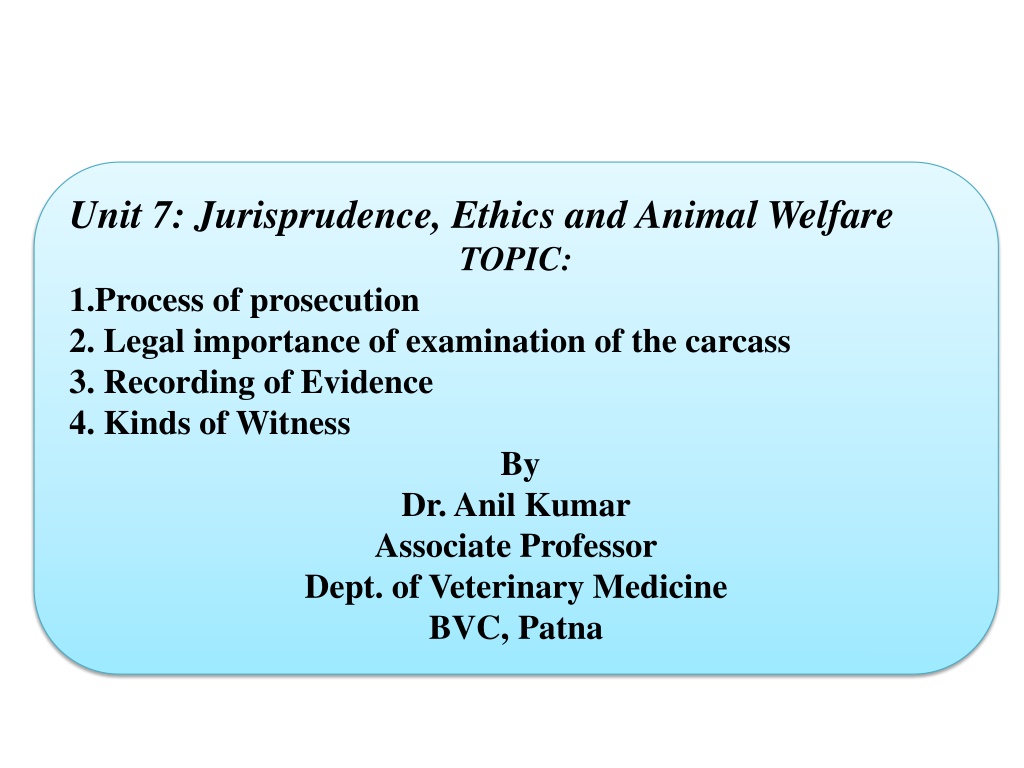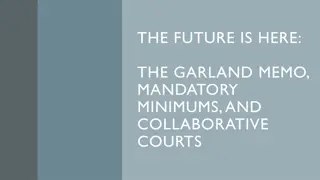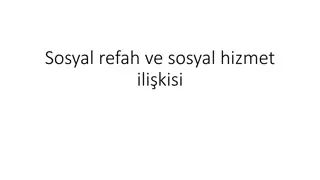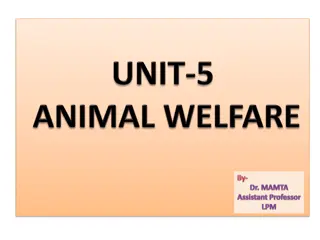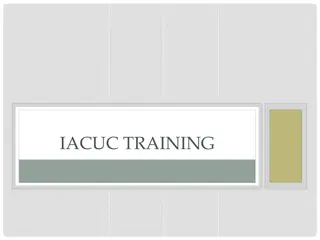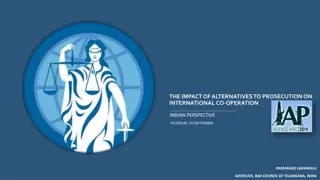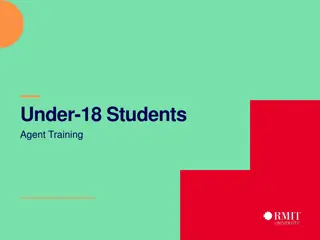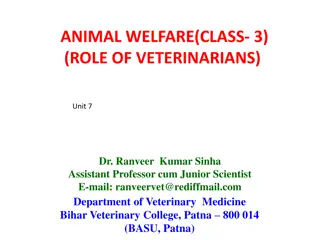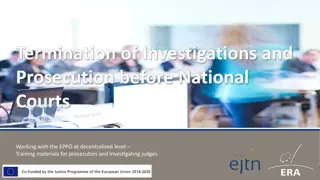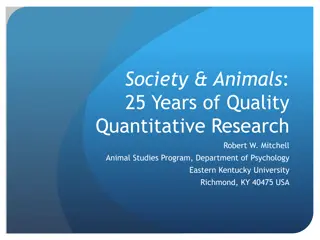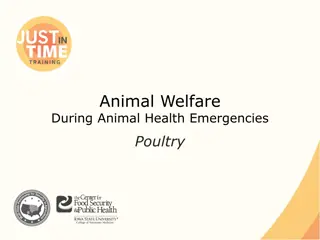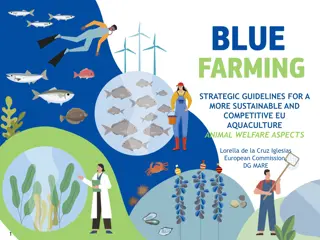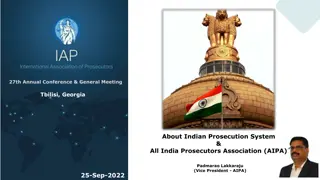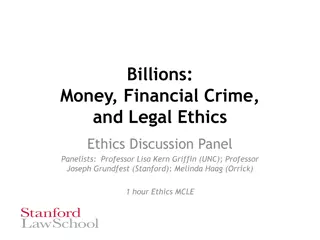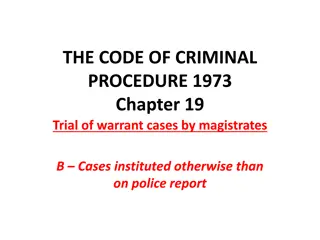Process of Prosecution in Animal Welfare Cases
Learn about the essential steps in the process of prosecuting individuals for criminal injuries to animals, including lodging reports, examining carcasses, and recording evidence. Discover the legal significance of postmortem examinations and the types of witnesses involved in such cases.
Download Presentation

Please find below an Image/Link to download the presentation.
The content on the website is provided AS IS for your information and personal use only. It may not be sold, licensed, or shared on other websites without obtaining consent from the author.If you encounter any issues during the download, it is possible that the publisher has removed the file from their server.
You are allowed to download the files provided on this website for personal or commercial use, subject to the condition that they are used lawfully. All files are the property of their respective owners.
The content on the website is provided AS IS for your information and personal use only. It may not be sold, licensed, or shared on other websites without obtaining consent from the author.
E N D
Presentation Transcript
Unit 7: Jurisprudence, Ethics and Animal Welfare TOPIC: 1.Process of prosecution 2. Legal importance of examination of the carcass 3. Recording of Evidence 4. Kinds of Witness By Dr. Anil Kumar Associate Professor Dept. of Veterinary Medicine BVC, Patna
Process of prosecution If the owner of an animal wishes seek redress for his grievances in a court of law for his animal having been criminally injured, he has to lodge: A report at the nearest police station mentioning the names of the culprit as well as of the witnesses. In the case of a Government animal, the veterinary surgeon in charge of the area, wherein the animal has been injured, is supposed to lodge a report with the police. The injured or dead animal should be examined by the veterinary surgeon either in the hospital, or on the spot, to give his report to the police. His report would normally provide material evidence in the court for prosecution and should, therefore, be carefully drafted.
Legal importance of examination of the carcass The object of the examination is to ascertain the cause and the manner of death (criminal violence/ in sudden deaths from unknown causes). Every possible cause should be investigated before venturing (proceed) an opinion as to the cause of death. Not only should the postmortem lesions, both external and internal, be carefully examined All circumstantial evidence given and the surroundings, such as the field, or the land, etc., where the animal was found dead should be described. The history, as given by the owner, should be noted briefly and signed by the owner, or left thumb impression (right thumb impression, if a woman) taken if he or she is illiterate.
In our climatic conditions, it is necessary to perform the post- mortem as early as possible to avoid decomposition and mutilation of carcass by carrion animals The pro-forma for recording a post-mortem report must be filled in triplicate at the time of the postmortem examination, signed, timed and dated. Maintain a vetero- legal register Where only bones are available, record the detailed description of the important bones, to identify the species, the sex and age if possible of the animal. The odour and feel of bones should be noted carefully for assessing the time of death, as recent bones have a peculiar odour and a greasy fee.
Recording of Evidence The evidence is then recorded in the following manner: 1. Examination-in-Chief 2. Cross-examination 3. Re-examination 4. Questions put by the Judge, Juror or Assessor.
Examination-in-Chief: This is the first examination of a witness by the party which calls him. In Government prosecution cases the prosecuting inspector, as a rule, first examines the witness to elicit the principal facts concerning the case. , ,
If the witness is summoned by a private party, he is first examined by the pleader of that party. , , , , , '' '' , " " , : '' ? ? ?''
The witness may also be asked such questions which tend to test his veracity (reality) , to discover his knowledge, experience and qualifications and even to injure his character.
In some instances, cross-examination acts as a double-edged sword, which cuts both ways, i.e. it may damage the defence as much as, and sometimes more than, the prosecution, specially if counsel is not familiar with Veterinary Science, and the witness happens to be well up in his subject, and at the same time honest and straightforward. , , , , , - , , , There is no time-limit for cross-examination. It may last for hours or even days, although the presiding officer can always disallow irrelevant questions and cut short the cross- examination.
The prosecuting inspector or counsel, who conducts the examination-in chief, has the right to re-examine the witness to explain any discrepancies that may have occurred during cross-examination; \ but the witness should not introduce any new subject without the consent of the judge or opposing counsel (lawyer), lest he should become liable to cross-examination on the new point thus introduced.
, , , Question put bythe Judge, Juror or Assessor The Judge, Juror or Assessor may question the witness at any stage to clear up doubtful points ;
Veterinary Evidence Veterinary evidence given before a court oflaw is of two types: (1). Documentary, and (2) Oral or parol. Documentary Evidence: This includes: (a) Veterinary certificates. (b) Vetero-Iegal reports. Oral evidence is more important than documentary evidence, since a person has to prove on oath or affirmation documentary evidence supplied by him to the court, that it is true and correct and is in his own handwriting.
Kinds of Witnesses Witnesses are of four kinds: Common Expert skilled and Hostile A common witness is one who testifies to the facts observed by himself An expert witness is someone who, because of his professional training, can draw opinions and inferences from facts that he has observed or that others have noticed Thus, it is clear that a veterinary witness is both common and expert
